Pressure-Amplified Structural Superiority in Silty Clays: Dynamic Divergence Between Undisturbed and Remolded States
Abstract
1. Introduction
2. Materials and Methods
2.1. Test Apparatus
2.2. Specimen Preparation
2.3. Test Program
3. Results and Discussion
3.1. Shear Stress (τd)–Dynamic Strain (γd) Relationship
- σ1d—effective axial consolidation stress (kPa);
- σ3d—effective lateral consolidation stress (kPa);
- εd—axial dynamic strain (%);
- ν—Poisson’s ratio.
3.2. Shear Modulus (Gd)–Dynamic Strain (γd)
3.3. Normalized Modulus Ratio (Gd/Gdmax)–Dynamic Strain (γd)
3.4. Damping Characteristics
3.5. Discussion
4. Conclusions and Prospect
4.1. Conclusions
- (1)
- Confining pressure exerts a significant influence on the dynamic parameters (τd, τdmax, Gd, Gdmax) of both undisturbed and remolded specimens; the τd–γd and Gd–γd relationship curves exhibit near-overlapping trajectories under low confining pressure (50 kPa), with deviation percentages remaining below 5%. However, with the confining pressure increasing to 300 kPa, the slope of τd and Gd with the increase of γd of the undisturbed soils is significantly higher than that of remolded soils, and the deviation percentage can reach 20–30%. This pressure-amplified discrepancy unequivocally confirms that high confining pressure activates and amplifies intrinsic structural superiority in undisturbed soils, through enhanced stress transfer efficiency within natural cementation networks and optimized particle interlocking, fundamentally altering soil dynamic behavior beyond 200 kPa threshold confining pressures.
- (2)
- The influence of confining pressure on the Gd/Gdmax is relatively minor for both undisturbed and remolded specimens, with their Gd/Gdmax–γd relationship curves confined within a narrow banded range exhibiting limited dispersion. A triphasic evolutionary characteristic is manifested in the progressive reduction of Gd/Gdmax with increasing γd: quasi-linear attenuation dominates within the 1 × 10−4 ≤ γd ≤ 1 × 10−2 strain range, followed by accelerated Gd/Gdmax reduction rates when γd exceeds 10−3. It is noteworthy that under high confining pressure (300 kPa), undisturbed soil specimens exhibit a distinct leftward shift in their stress-strain curves and sustain dynamic strains of higher magnitudes at equivalent modulus degradation levels. This phenomenon confirms that during cyclic loading, the structural integrity of undisturbed soil is preserved, thereby optimizing the energy distribution mechanism.
- (3)
- This study establishes that confining pressure exerts significantly less influence on damping ratios (λd) than do shear stress and Shear modulus, with λd–γd relationship curves converging when γd < 10−3 across pressure conditions. Crucially, undisturbed specimens exhibit λd values systematically 15–22% lower than those of remolded counterparts at equivalent shear strains. The maximum damping ratio (λdmax) of all specimens is confined within the range of 0.2–0.3, reflecting the limiting effect of pore fluid viscosity within the microstructure of silty clay.
- (4)
- The applicability of substituting remolded soils for undisturbed soils obeys the “depth-parameter” criterion: Substitution is permissible for normalized modulus ratio (Gd/Gdmax) analysis in shallow foundations (σc ≤ 100 kPa), where this parameter exhibits low sensitivity to structural state. However, dynamic parameters for deep-buried structures strictly prohibit substitution with remolded soil parameters. Under high confining pressures, τdmax differences reach 20–30%, with systematic λd deviations of 15–22%. Using remolded soil parameters for seismic design would cause severe safety hazards.
4.2. Prospect
- (1)
- The current comparison using only four discrete confining pressure levels may not fully represent the dynamic characteristics of undisturbed soils across different depths; future studies should correlate confining pressures with in situ burial depths of undisturbed samples.
- (2)
- The exclusive application of unidirectional cyclic loading fails to comprehensively simulate seismic loading conditions; subsequent research should incorporate cyclic stress ratio variations and multidirectional loading protocols to elucidate coupled stress-path effects.
- (3)
- Existing analyses primarily described phenomenological trends without theoretical quantification; advancing this requires integrating experimental outcomes with intrinsic soil properties—particularly mineral composition, particle size distribution, and microstructural features—to establish mechanistic linkages.
Author Contributions
Funding
Data Availability Statement
Conflicts of Interest
References
- Sun, J.; Yuan, X.M. A state-of-art of research on dynamic modulus and damping ratio of soils. World Earthq. Eng. 2003, 19, 88–95. [Google Scholar]
- Li, J.J.; Kong, L.W. Response characteristics of dynamic parameters of expansive soil under the influence of stress history. J. Vib. Shock 2017, 36, 181–188. [Google Scholar]
- Hardin, B.O.; Black, W.L. Vibration modulus of normally consolidated clay. J. Soil Mech. Found. Div. 1968, 94, 353–369. [Google Scholar] [CrossRef]
- Kagawa, T. Moduli and damping factors of soft marine clays. J. Geotech. Eng. 1992, 118, 1360–1375. [Google Scholar] [CrossRef]
- Ishibashi, I.; Zhang, X. Unified dynamic shear moduli and damping ratios of sand and clay. Soils Found. 1993, 33, 182–191. [Google Scholar] [CrossRef]
- Qi, S.; Ma, W.; Zhang, X.; Wang, J.; Hu, X.; Wei, Z.; Liu, J. Effects of Remolding Water Content and Compaction Degree on the Dynamic Behavior of Compacted Clay Soils. Buildings 2024, 14, 2258. [Google Scholar] [CrossRef]
- Zhang, J.; Sun, Y.; Cao, J. Experimental study on the deformation and strength characteristics of saturated clay under cyclic loading. Adv. Civ. Eng. 2020, 2020, 7456596. [Google Scholar] [CrossRef]
- Lo Presti, D.C.F.; Jamiolkowski, M.; Pallara, O.; Cavallaro, A.; Pedroni, S. Shear modulus and damping of soils. Geotechnique 1997, 47, 603–617. [Google Scholar] [CrossRef]
- Dong, C.; Leng, W.M.; Li, Z.Y.; Zou, J.R. Study on cumulative plastic deformation of silty subgrade soil under repeated loading. Rock Soil Mech. 2014, 35, 3437–3442. [Google Scholar]
- Li, Y.R.; Yang, Z.C.; Zhang, J.J. Experimental study on dynamic characteristics of remolded lacustrine soft clay. Earthq. Eng. Eng. Vib. 2021, 41, 11–18. [Google Scholar]
- Wang, M.J.; Zhang, S.S.; Yang, X.H.; Zhang, C.; Yan, C.G. Dynamic characteristics of silty clay in flood irrigation areas under cyclic loading. Rock Soil Mech. 2025, 46, 1215–1227. [Google Scholar]
- Ren, H.P.; Liu, X.Z.; Xuan, M.M.; Ye, X.Y.; Li, Q.; Zhang, S. Investigation of cumulative plastic deformation of compacted silt under cyclic loading. Rock Soil Mech. 2021, 42, 1045–1055. [Google Scholar]
- Li, J.; Chen, S.X.; Jiang, L.F. Test study on the influences of dynamic stress and load history to the dynamic properties of the remolded red clay. Earth Sci. Res. J. 2016, 20, G1–G8. [Google Scholar] [CrossRef]
- Kawaguchi, T.; Tanaka, H. Formulation of Gmax from reconstituted clayey soils and its application to Gmax measured in the field. Soils Found. 2008, 48, 821–831. [Google Scholar] [CrossRef]
- Huang, C.X.; Wang, X.H.; Zhou, H.; Qin, D.C. Dynamic elastic modulus and damping ratio of unsaturated red clay. Geotech. Geol. Eng. 2020, 38, 873–881. [Google Scholar] [CrossRef]
- Xi, Y.; Sun, M.; Hua, X.; Zhang, Y.; Yuan, Y. Study on the Dynamic Deformation Characteristics of Artificial Structural Loess. Buildings 2025, 15, 1198. [Google Scholar] [CrossRef]
- Li, J.H.; Shen, Z.J. Study on mechanism of micro-failure of structured soils. Yantu Lixue (Rock Soil Mech.) 2007, 28, 1525–1532. [Google Scholar]
- Dyvik, R.; Høeg, K. Comparison of tests on undisturbed and reconstituted silt and silty sand. In Physics and Mechanics of Soil Liquefaction; Routledge: Abingdon, UK, 2018; pp. 159–167. [Google Scholar]
- Chen, Y.; Chen, Y.; Huang, B. Experimental study on influences of static and cyclic deformations on structural soft clay with stress level. Yanshilixue Yu Gongcheng Xuebao/Chin. J. Rock Mech. Eng. 2006, 25, 937–945. [Google Scholar]
- Song, Q.J.; Cheng, L.; He, W.M. Experimental study of the dynamic shear modulus and damping ratio of silty clay on Eastern Henan Plain. China Earthq. Eng. J. 2020, 42, 1013–1018. [Google Scholar]
- Zhao, Y.; Li, Y.H.; Zhao, K.; Zhang, P. Comparative experimental study on damping ratio of remolded and undisturbed weathered soil. Yangtze River 2015, 46, 80–83, 105. [Google Scholar]
- Tong, Y.D.; Yang, G.; Liu, H.L. Comparative test study on dynamic characteristics of undisturbed and remolded marine silt. China Earthq. Eng. J. 2014, 36, 952–957. [Google Scholar]
- Guo, J.P. Study on Stress-Strain and Strength Characteristics of Typical Silty Clay in Zhengzhou. Master’s Thesis, North China University of Water Resources and Electric Power, Zhengzhou, China, 2019. [Google Scholar]
- Fan, J.W.; Zhang, Y.F.; Li, J.; Yuan, K. Study on mechanical properties of loess-like silty clay in Zhengzhou. China Railw. Sci. 2025, 46, 15–26. [Google Scholar]
- Zhan, J.Y.; Chen, G.X.; Yang, W.L.; Hu, Q.X. Experimental study on dynamic shear modulus ratio and damping ratio of Quaternary sedimentary soil in Suzhou. Chin. J. Geotech. Eng. 2012, 34, 559–566. [Google Scholar]
- Chen, D.M.; Tian, W.X.; Duan, R. Statistical study on dynamic shear modulus ratio and damping ratio of typical soils in Xi’an region. World Earthq. Eng. 2012, 28, 136–142. [Google Scholar]
- Chen, G.X.; Liu, X.Z.; Zhu, D.H.; Hu, Q.X. Experimental study on dynamic shear modulus ratio and damping ratio of recent deposited soils in Nanjing. Chin. J. Geotech. Eng. 2006, 28, 1023–1027. [Google Scholar]
- Ma, L.N.; Shi, L.; Yang, B.; Xu, H.X.; Zhang, R.L. Experimental study on dynamic characteristics of silty clay in Xiong’an New Area. J. Chongqing Jiaotong Univ. (Nat. Sci.) 2024, 43, 24–31. [Google Scholar]
- GB/T 50123-2019; Standard for Geotechnical Testing Method. China Planning Press: Beijing, China, 2019.
- Seed, H.B.; Lee, K.L. Liquefaction of saturated sands during cyclic loading. J. Soil Mech. Found. Div. 1966, 92, 105–134. [Google Scholar] [CrossRef]
- Xie, D.Y. Tu Dong Li Xue [Soil Dynamics]; Higher Education Press: Beijing, China, 2011. [Google Scholar]
- Chen, G.X. Rock and Soil Seismic Engineering; Science Press: Beijing, China, 2007. [Google Scholar]
- Hardin, B.O.; Drnevich, V.P. Shear modulus and damping in soils: Design equations and curves. J. Soil Mech. Found. Div. 1972, 98, 667–692. [Google Scholar] [CrossRef]
- Jiang, Q.; Rong, M.; Peng, Y. Quantitative analysis of the influence of dynamic shear modulus ratio on response spectra. J. Jilin Univ. (Earth Sci. Ed.) 2015, 45, 876–885. [Google Scholar]
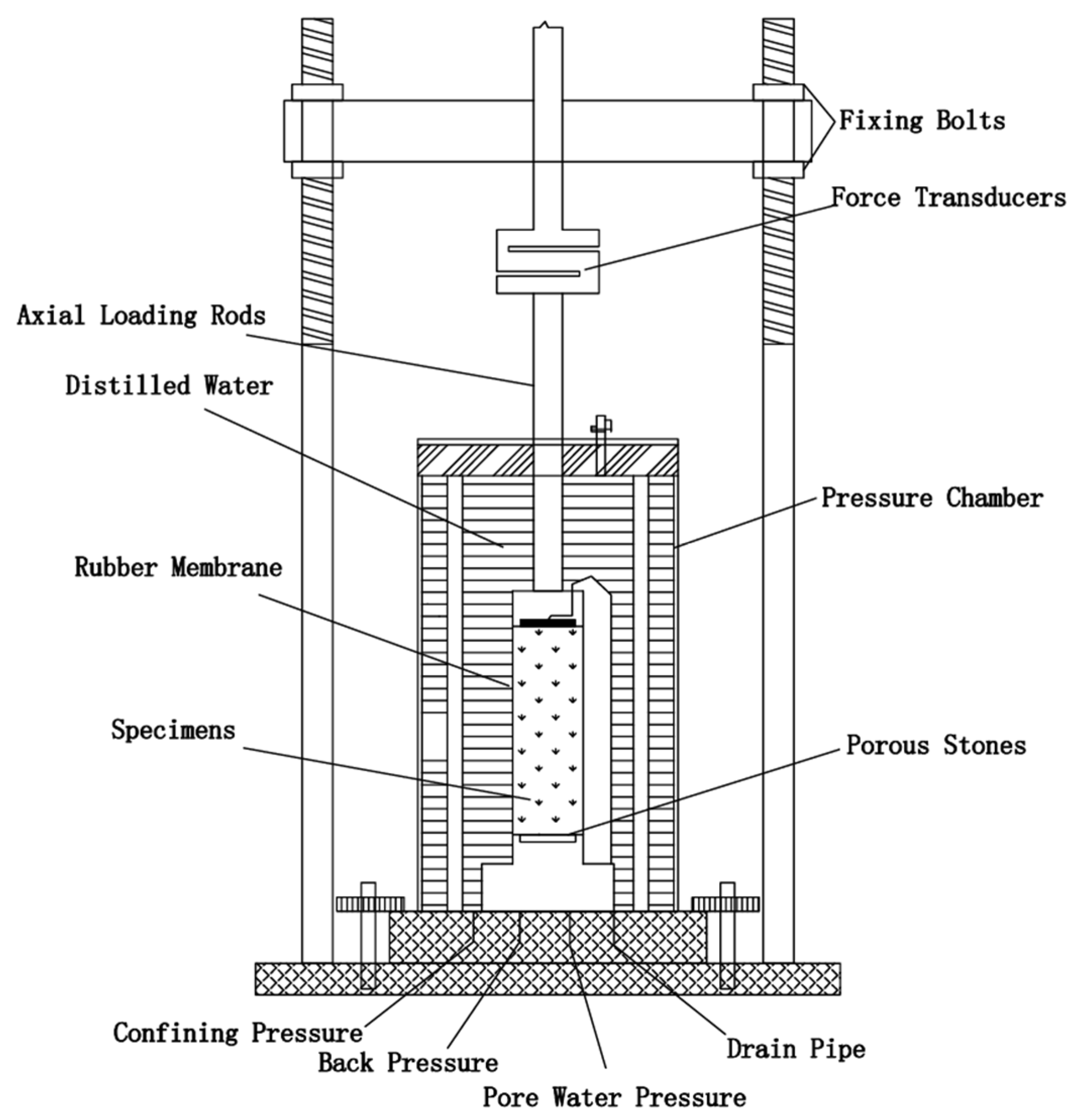
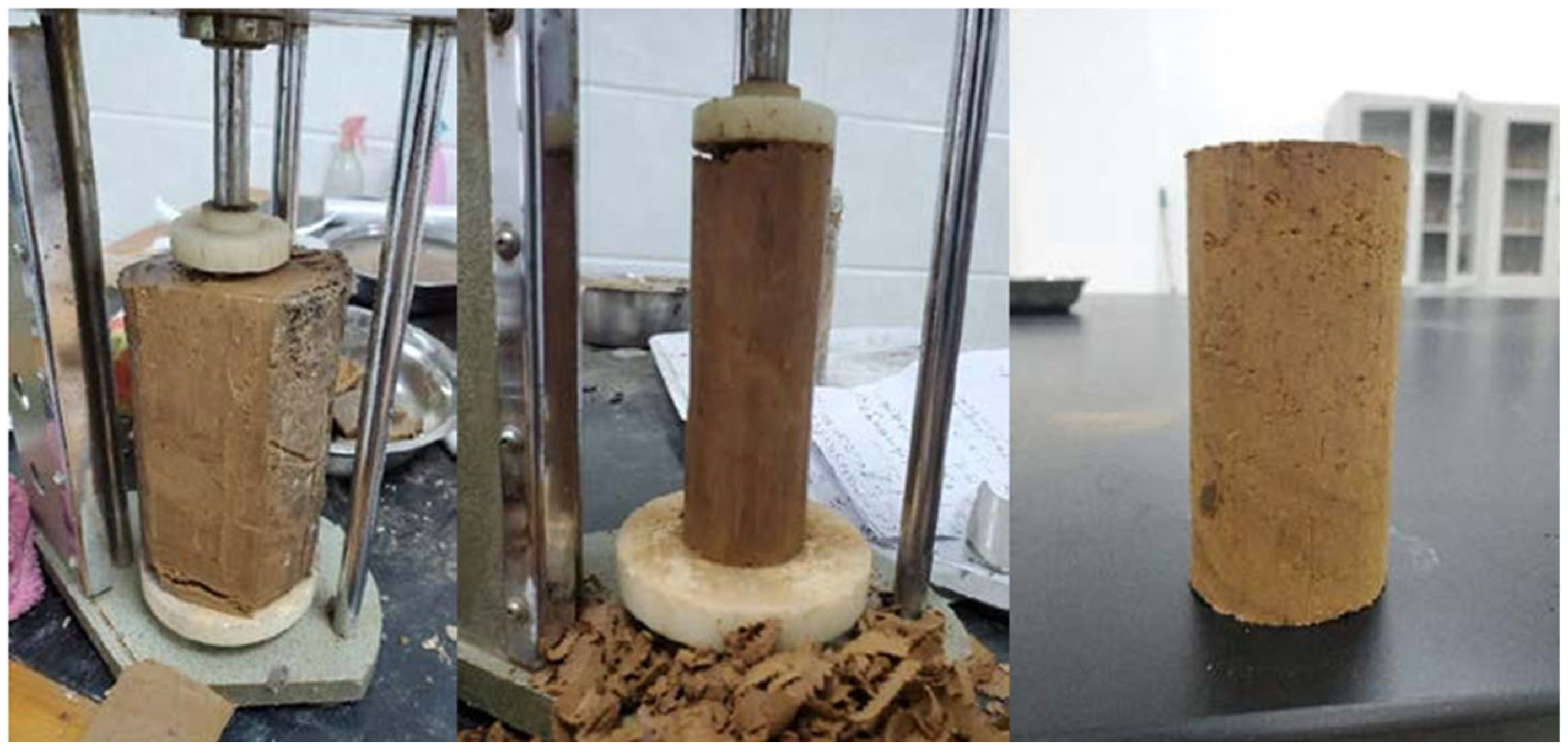
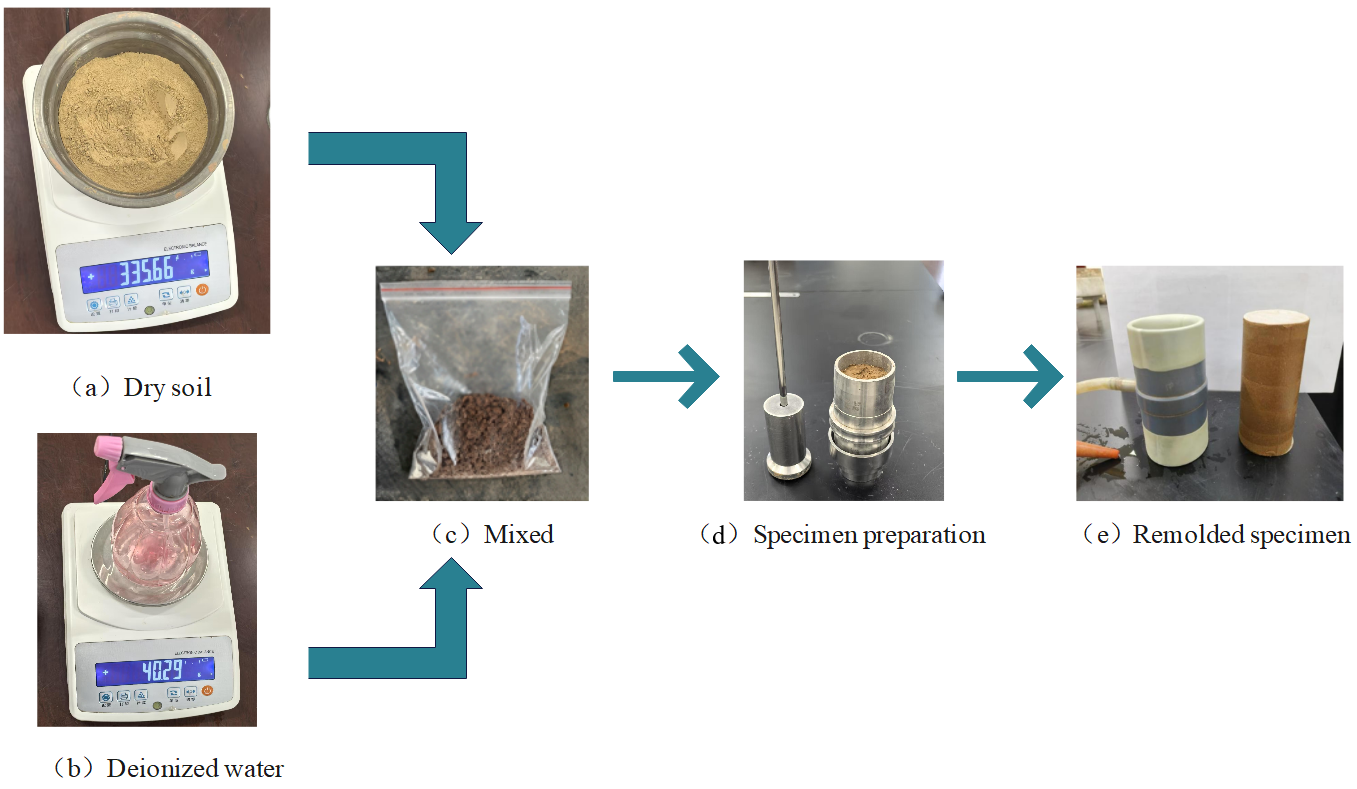

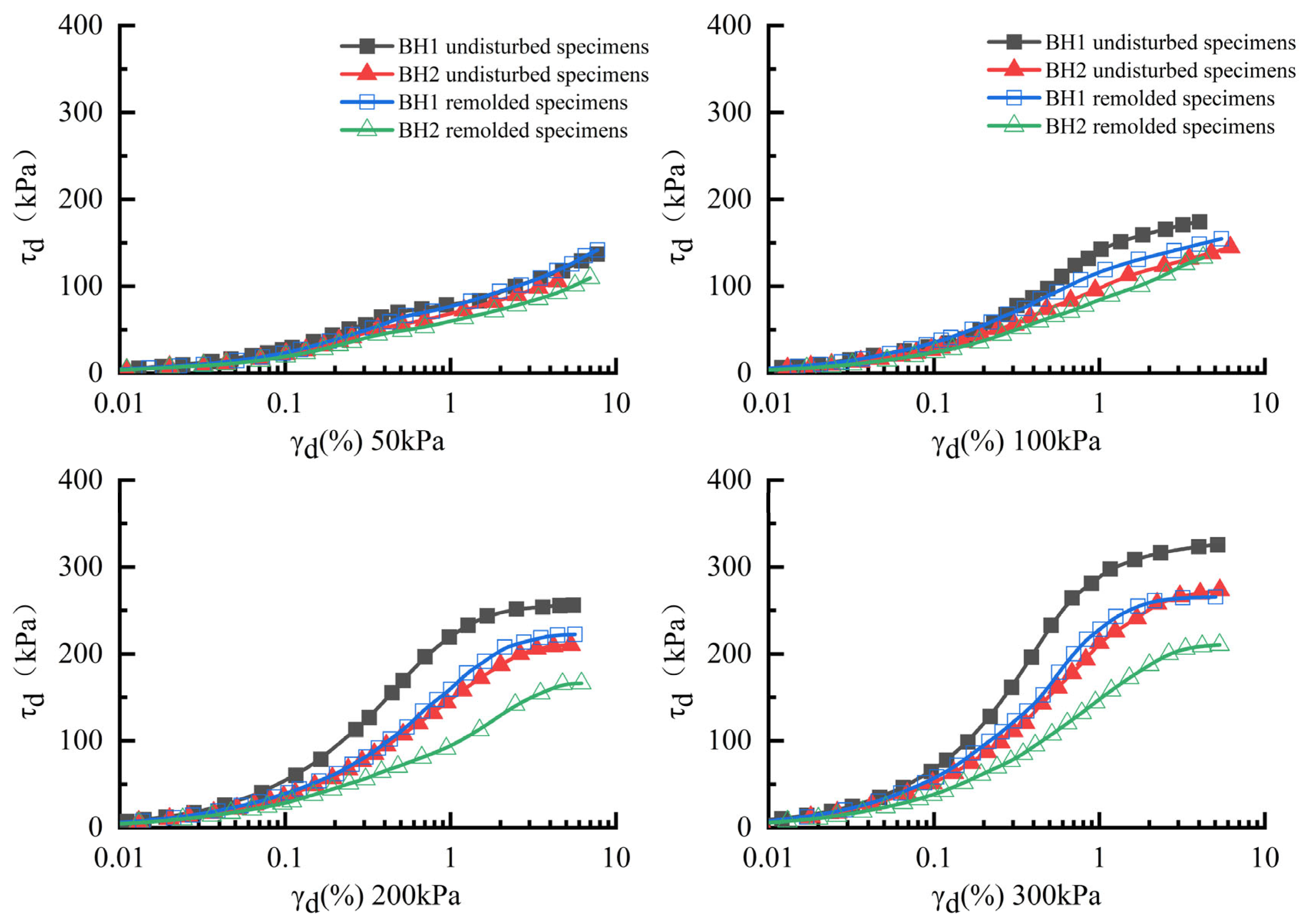
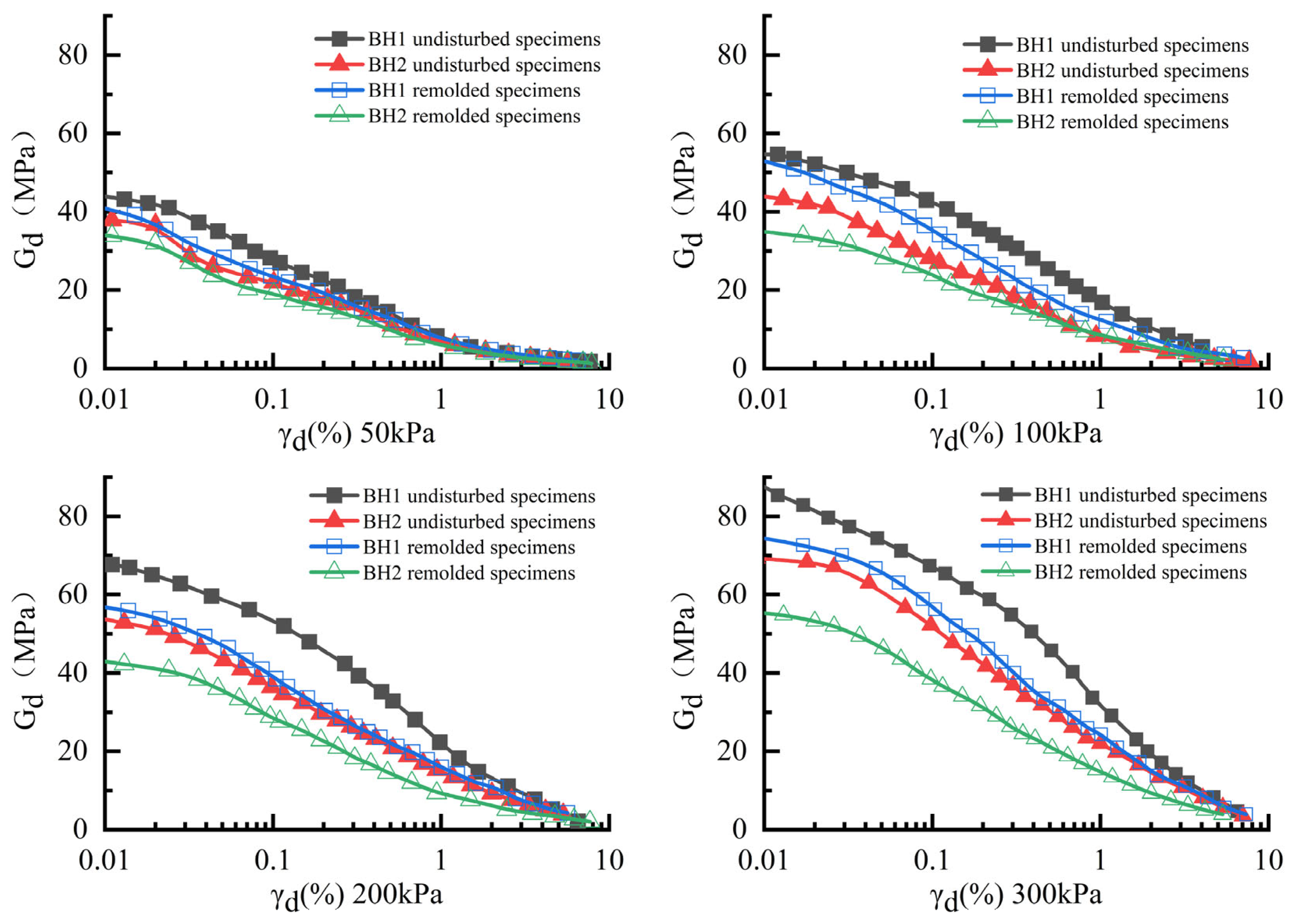
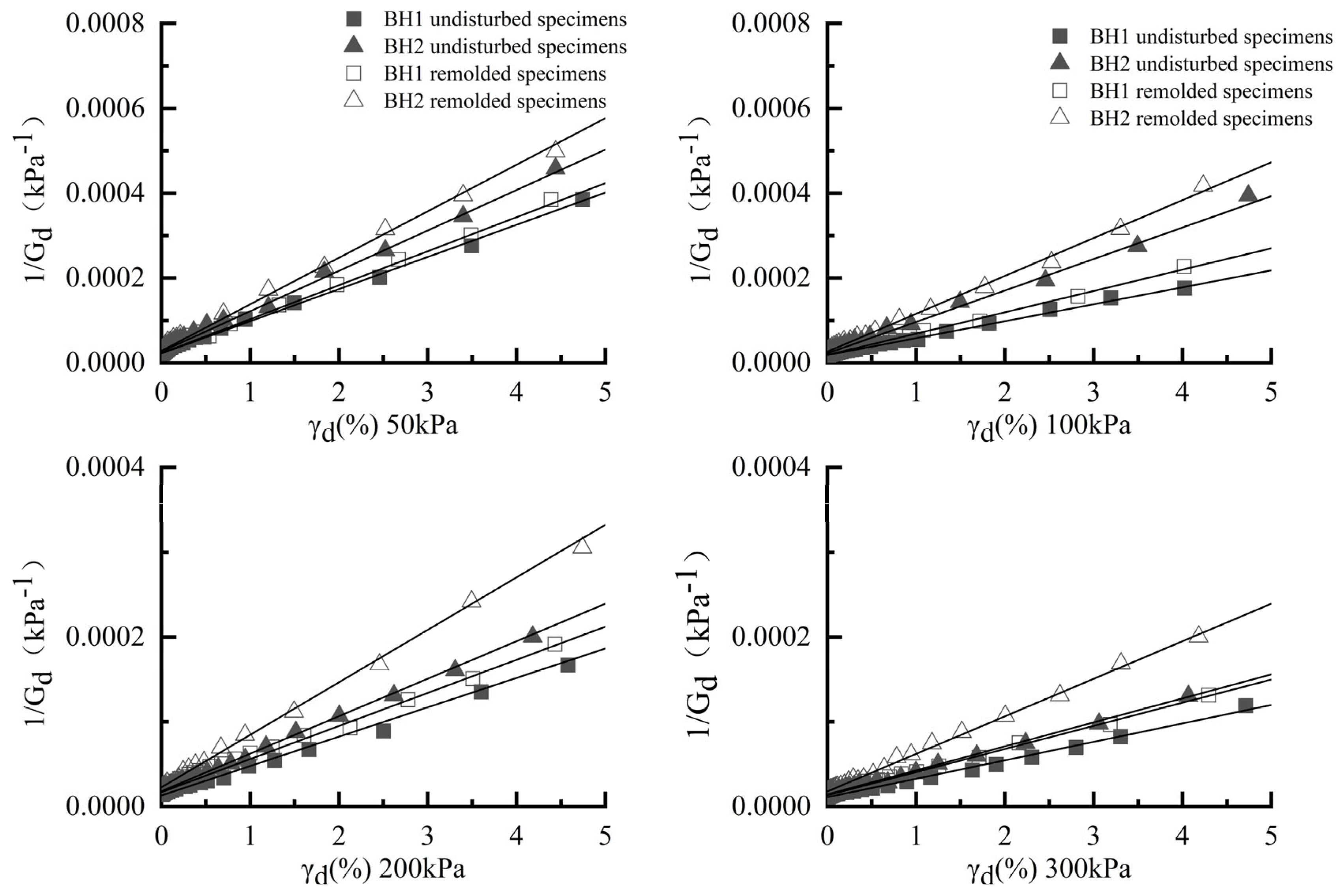
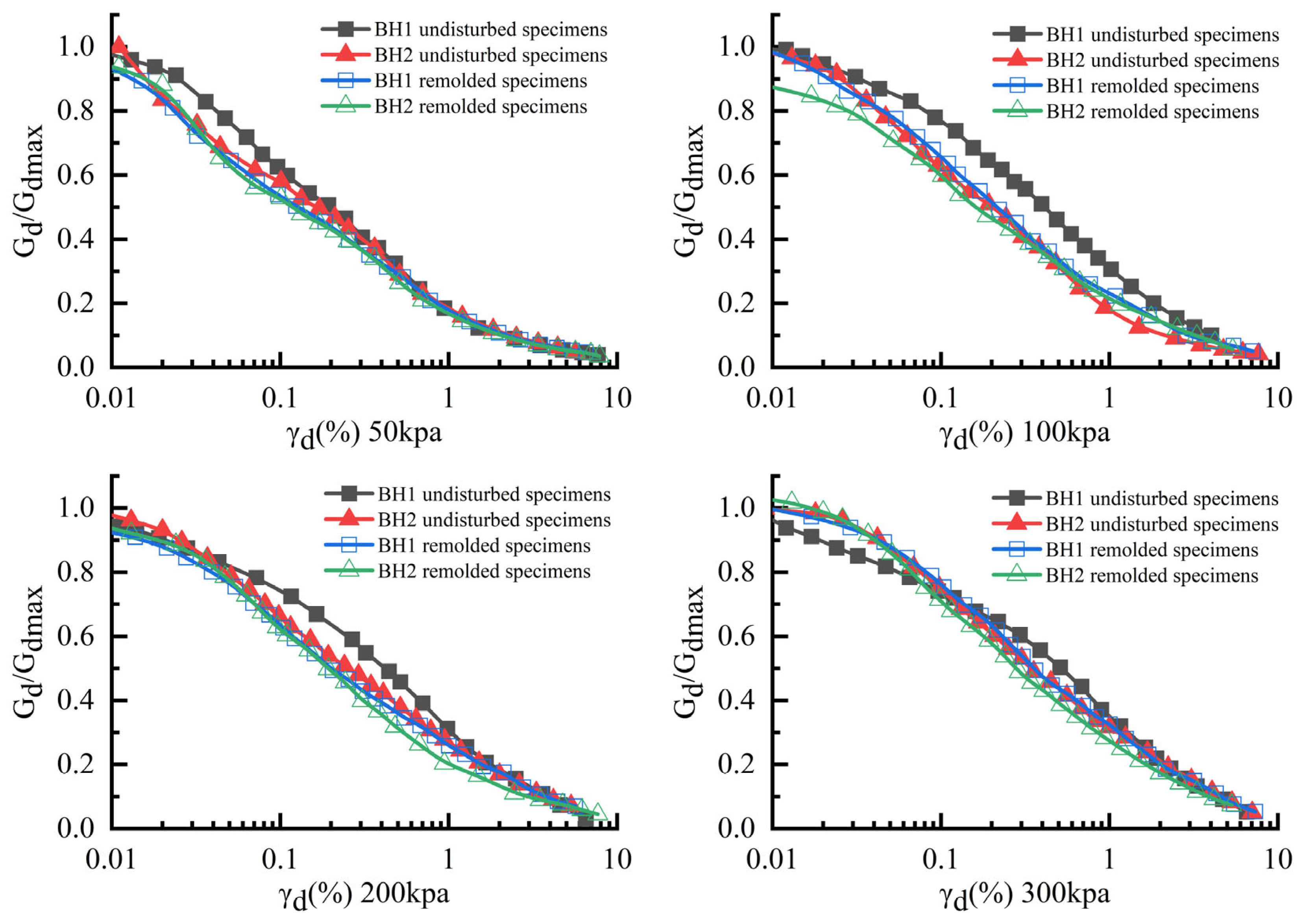

| Borehole | Depths (m) | Dry Density (g/cm3) | Liquid Limit (%) | Plastic Limit (%) | Water Content (%) |
|---|---|---|---|---|---|
| BH1 | 5 | 1.62 | 49.2 | 25.1 | 28.5 |
| 10 | 1.73 | 37.3 | 19.3 | 23.6 | |
| 20 | 1.71 | 41.4 | 22.7 | 20.4 | |
| 30 | 1.69 | 45.6 | 28.1 | 21.7 | |
| BH2 | 6 | 1.65 | 40.3 | 24.7 | 24.6 |
| 12 | 1.66 | 44.5 | 28.5 | 25.3 | |
| 20 | 1.64 | 37.9 | 21.2 | 22.4 | |
| 30 | 1.63 | 42.4 | 24.3 | 23.6 |
| Borehole | Specimen Type | Experimental State | Confining Pressure (kPa) | τdmax (kPa) | Borehole | Specimen Type | Experimental State | Confining Pressure (kPa) | τdmax (kPa) |
|---|---|---|---|---|---|---|---|---|---|
| BH1 | Undisturbed specimens | Saturation | 50 | 137 | BH2 | Undisturbed specimens | Saturation | 50 | 106 |
| 100 | 174 | 100 | 144 | ||||||
| 200 | 256 | 200 | 210 | ||||||
| 300 | 325 | 300 | 273 | ||||||
| Remolded specimens | Saturation | 50 | 134 | Remolded specimens | Saturation | 50 | 101 | ||
| 100 | 155 | 100 | 132 | ||||||
| 200 | 222 | 200 | 166 | ||||||
| 300 | 265 | 300 | 210 |
| Borehole | Specimen Type | Experimental State | Confining Pressure (kPa) | Intercept a | Slope b | Gdmax (MPa) | R2 |
|---|---|---|---|---|---|---|---|
| BH1 | Undisturbed specimens | Saturation | 50 | 2.22 × 10−5 | 7.58 × 10−5 | 45.05 | 0.9915 |
| 100 | 1.88 × 10−5 | 3.99 × 10−5 | 53.15 | 0.9998 | |||
| 200 | 1.39 × 10−5 | 3.46 × 10−5 | 71.76 | 0.9919 | |||
| 300 | 1.10 × 10−5 | 2.17 × 10−5 | 90.91 | 0.9979 | |||
| Remolded specimens | Saturation | 50 | 2.28 × 10−5 | 8.01 × 10−5 | 43.86 | 0.9878 | |
| 100 | 2.09 × 10−5 | 5.03 × 10−5 | 53.76 | 0.9932 | |||
| 200 | 1.39 × 10−5 | 3.90 × 10−5 | 61.48 | 0.9964 | |||
| 300 | 1.34 × 10−5 | 2.73 × 10−5 | 74.63 | 0.9940 | |||
| BH2 | Undisturbed specimens | Saturation | 50 | 2.64 × 10−5 | 9.52 × 10−5 | 37.88 | 0.9960 |
| 100 | 2.23 × 10−5 | 7.42 × 10−5 | 44.84 | 0.9863 | |||
| 200 | 1.82 × 10−5 | 4.42 × 10−5 | 54.95 | 0.9979 | |||
| 300 | 1.44 × 10−5 | 2.83 × 10−5 | 69.44 | 0.9964 | |||
| Remolded specimens | Saturation | 50 | 2.76 × 10−5 | 9.62 × 10−5 | 36.21 | 0.9905 | |
| 100 | 2.51 × 10−5 | 8.94 × 10−5 | 39.92 | 0.9956 | |||
| 200 | 2.18 × 10−5 | 6.19 × 10−5 | 45.86 | 0.9841 | |||
| 300 | 1.85 × 10−5 | 6.26 × 10−5 | 53.87 | 0.9980 |
Disclaimer/Publisher’s Note: The statements, opinions and data contained in all publications are solely those of the individual author(s) and contributor(s) and not of MDPI and/or the editor(s). MDPI and/or the editor(s) disclaim responsibility for any injury to people or property resulting from any ideas, methods, instructions or products referred to in the content. |
© 2025 by the authors. Licensee MDPI, Basel, Switzerland. This article is an open access article distributed under the terms and conditions of the Creative Commons Attribution (CC BY) license (https://creativecommons.org/licenses/by/4.0/).
Share and Cite
Hu, J.; Zhou, B.; Li, P.; Wang, J.; Yang, Y. Pressure-Amplified Structural Superiority in Silty Clays: Dynamic Divergence Between Undisturbed and Remolded States. Buildings 2025, 15, 2319. https://doi.org/10.3390/buildings15132319
Hu J, Zhou B, Li P, Wang J, Yang Y. Pressure-Amplified Structural Superiority in Silty Clays: Dynamic Divergence Between Undisturbed and Remolded States. Buildings. 2025; 15(13):2319. https://doi.org/10.3390/buildings15132319
Chicago/Turabian StyleHu, Jinhu, Banglong Zhou, Penggang Li, Jing Wang, and Yayuan Yang. 2025. "Pressure-Amplified Structural Superiority in Silty Clays: Dynamic Divergence Between Undisturbed and Remolded States" Buildings 15, no. 13: 2319. https://doi.org/10.3390/buildings15132319
APA StyleHu, J., Zhou, B., Li, P., Wang, J., & Yang, Y. (2025). Pressure-Amplified Structural Superiority in Silty Clays: Dynamic Divergence Between Undisturbed and Remolded States. Buildings, 15(13), 2319. https://doi.org/10.3390/buildings15132319





